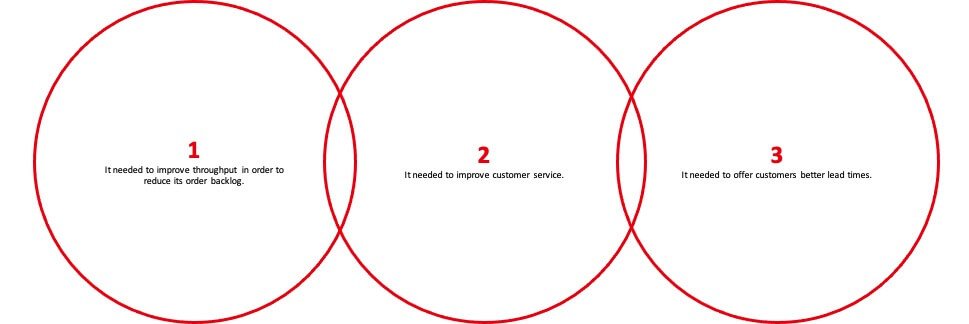How Industrial Predictive Analytics is Transforming Manufacturing

Faced with intense competition, rising consumer expectations, and changing regulations — not to mention the day-to-day challenges that come with the job — manufacturers can’t afford to be unprepared. The fact of the matter is that in order to not only survive, but thrive in the world of modern manufacturing, manufacturers need to embrace the latest digital innovations, starting with industrial predictive analytics.
Most manufacturers are familiar with the concept of descriptive analytics — that is, analytics applied to historical data in order to make sense of things that have happened — given that it comes standard with most enterprise resource planning (ERP) systems. And while descriptive analytics is certainly valuable in that it can, say, tell you the rate of production on a machine at any given point in time or your percentage of on-time delivery, it doesn’t provide any real foresight into the future.
That’s where predictive analytics comes in. Predictive analytics enables you to use historical data, including ERP data, machine data, and data from other devices, such as IoT sensors and RFID systems, to determine what is likely to happen in the near future. For example, you could run predictive analytics on sales data from previous years in order to forecast demand for the coming year, thereby enabling you to make more informed decisions about how much production capacity you require and when. This is just one of many possible applications for manufacturing predictive analytics. Let’s look at some more.
- 11 Major Benefits to Using Manufacturing Predictive Analytics
- Industrial Predictive Analytics in Action
- Prescriptive Analytics: The Next Frontier
- How to Get Started with Industrial Predictive Analytics
- Discover the Power of Predictive Analytics with Protected Flow Manufacturing
11 Major Benefits to Using Manufacturing Predictive Analytics
Through the power of predictive analytics, manufacturing companies can realize a wide range of benefits, including:
- Quality Improvements: Quality improvements are typically the result of repeated trial and error as you fine-tune and tweak existing processes; this is often a highly iterative process, one that can be tedious, time-consuming, and costly. Industrial predictive analytics sidesteps much of this frustration by providing you with a comprehensive view of what’s working, what isn’t, and what changes need to be made in order to improve outcomes. No need to test and test again — predictive analytics does much of the work for you. Best of all, once strategic adjustments have been made, you can then automate these processes, enabling you to consistently deliver a high quality product.
- On-time Delivery: In order to earn and keep customers’ loyalty, a high on-time delivery rate is a must. Predictive analytics makes it possible to see not only what needs to be delivered and when, but how likely a delivery is to be on time based on a number of factors, including available resources and other works in progress. Using this information, you can make more strategic decisions about how to move jobs through your work center in order to ensure that orders are delivered on time, every time.
- More Accurate Demand Forecasting: Manufacturing predictive analytics builds upon traditional demand forecasting by analyzing order history, incoming orders, and external factors such as current economic conditions and changes in local infrastructure, rather than historical data alone. In doing so, predictive analytics solutions are able to generate more accurate, detailed forecasts for the future, so you can determine exactly how much safety stock you need to carry throughout the year.
- Better Machine Utilization: Machinery is expensive, complex, and a major investment, so it’s imperative that you maximize the value of every piece of equipment. Industrial predictive analytics provides a critical lens into machine utilization, including expected speeds, performance, and output; you can then perform comparative analysis against forecasted demand to identify process improvements and optimize shop floor operations. You can even automate much of this analysis to save valuable time.
- Predictive Maintenance: In the recent past, manufacturers would perform routine scheduled maintenance in order to identify potential problems before they had the chance to take place, thus keeping machinery in peak working condition. Although this approach — preventative maintenance — was a major step up from reactive maintenance, there was still room for improvement. With predictive analytics, preventative maintenance becomes predictive maintenance.Here’s how: With industrial predictive analytics, maintenance is based not only on the number of hours a machine runs, but also on the mix running through that machine — that is, the different jobs that run through the machine and the amount of strain they place on the machinery. This allows for more visibility into when things are likely to go wrong and what tooling needs to be changed than traditional preventative maintenance.
- Reduced Downtime: As you’ve likely already pieced together, because it supports optimal machine utilization and predictive maintenance, predictive analytics also enables you to reduce downtime, saving time and money in the process.
- Optimized Sales Revenue: Sales revenue is dependent upon your understanding of the customer. Manufacturing predictive analytics enables you to look at the customer’s purchase history — which products they’ve ordered in the past in what quantities and so on — and predict with greater accuracy what they’re likely to purchase in the future. This level of insight expedites the sales cycle because sales representatives are able to proactively start activities to help customers make the decision to purchase.Predictive analytics also enables sales teams to engage in more effective upselling and cross-selling because they’re able to recommend products that are complementary to past purchases. These personalized recommendations not only have the power to increase sales revenue, but to help sales reps build stronger customer relationships that go beyond just taking an order.
- Optimized Production Capacity: Because it enables you to look into the future, industrial predictive analytics makes it possible to proactively identify bottlenecks on your shop floor and conceive of solutions to regain flow through various work centers. By resolving potential problems before they have the chance to become actual problems, you can avoid having to expedite parts.
- Make Sense of Big Data: ERP systems typically generate massive quantities of data; the challenge lies in turning this data into usable information. By applying predictive analytics to ERP data, you can derive actionable insights, presented in a workable format, to help grow your business.Predictive analytics also enables you to identify key performance indicators and recognize patterns that you wouldn’t otherwise notice. Traditionally, data models were built to answer a question — for example, how many people within a certain geographical region have purchased products from you, or which machines were most likely to give you trouble on a given date. Now, thanks to pattern recognition and trend analysis, predictive analytics can tell you more about what is in the data and answer questions you didn’t even know how to ask.
- Better Supplier Management: When working with suppliers, the more information you can provide them with, the more efficient your supply chain will be. Since industrial predictive analytics makes predictions about what is going to happen based on what has already come to pass, you can share more information — especially information about potential supply chain bottlenecks — with suppliers than ever before. In this way, predictive analytics allows for more productive dialogue to ensure that parts arrive on time and strengthens current and future supplier relationships.
- Better Inventory Management: Manufacturing predictive analytics supports material planning by providing a clear and accurate picture of what’s to come — namely, which materials you need, when you’ll need them, and in what quantity. By improving inventory management, predictive analytics can also reduce work in process, which reduces the overall operation cycle — a major improvement across the entire business that can generate significant financial savings.
Industrial Predictive Analytics in Action
If predictive analytics sounds like something from the pages of a science fiction novel, we assure you, it isn’t — real manufacturing are realizing its benefits every single day. In fact, for an example of predictive analytics in action, look no further than this use case from Graphicast.
After experiencing a surge of customer orders that created a considerable backlog, Graphicast, a major supplier of ZA12, zinc aluminum alloy castings, faced three challenges:
One of the primary things that prevented Graphicast from overcoming these challenges was its legacy ERP system, which did not offer predictive analytics functionality and, therefore, could not dynamically adjust schedules to changing real-world conditions.
We worked with Graphicast to implement Protected Flow Manufacturing (PFM), our dynamic scheduling solution. PFM features an application known as the “Predictor,” which uses predictive analytics to run simulations on how each job will run through different resources based on its priority. Based on the results of this simulation, PFM is able to predict where bottlenecks are most likely to occur, what issues a job is likely to encounter that could lead to it being late, and when a job is most likely to finish.
Thanks to PFM — and to predictive analytics — Graphicast is now able to more intelligently schedule jobs, thereby accelerating plant throughput. This has drastically reduced the number of late orders leaving the plant, virtually eliminated Graphicast’s backlog, and enabled the company to earn more in exchange for offering customers expedited service.
Prescriptive Analytics: The Next Frontier
In addition to descriptive and predictive analytics, there is a third form of business analytics, though it is still somewhat experimental. Prescriptive analytics describes the use of machine learning to generate recommendations and make strategic decisions. It accomplishes this by pulling data from both descriptive and predictive sources, running that data through algorithms, creating machine learning models, and using its findings to determine the best course of action based on a specific goal or objective.
Prescriptive analytics is still something of an emerging technology in the manufacturing field, however, we expect it to gain momentum in the coming years as manufacturers continue to look for innovative ways to optimize processes and achieve greater ROI.
How to Get Started with Industrial Predictive Analytics
Every predictive analytics initiative needs to start with a solid data foundation. In order to create that foundation, you’ll need the following:
- A Single Source of Truth: Oftentimes, data is spread out across multiple different systems, spreadsheets, and other locations, which can make it more challenging to analyze and derive meaningful insights from. By creating a single source of truth, you’re effectively aggregating all data within a single, centralized repository, making it easier to analyze.
- Clean Data: Dirty data — that is, data that is inconsistent, inaccurate, incomplete, incorrect, or outdated — can easily skew the results of predictive analysis, so it’s important that you “cleanse” data before you use it. Cleansing data is simpler than it might sound and entails removing data that is no longer relevant, eliminating duplicate values, ensuring that all formatting is consistent, and correcting any typos, misspellings, or other errors.
- A Well-defined Data Strategy: Defining your data strategy is as simple as figuring out what it is you hope to achieve with predictive analytics. Do you want to increase throughput? Reduce or eliminate your backlog? Increase revenue? Improve your on-time delivery rate? Having a clear sense of what your goals, objectives, and priorities are can help ensure success with industrial predictive analytics.
Discover the Power of Predictive Analytics with Protected Flow Manufacturing
If you’re wondering whether predictive analytics is right for your company, the answer is “yes” — and Synergy Resources is here to help you get started. We’ve worked with over 800 manufacturers to improve their on-time delivery rate, optimize shop floor flow, prevent inventory shortages, and eliminate expediting using PFM.
PFM integrates with your company’s existing ERP system and, through the power of predictive analytics, generates actionable insights from your ERP data, such as how jobs are likely to perform and where they’re likely to run into trouble. PFM then uses this information to dynamically schedule jobs, prioritizing them based on their threat level — that is, how likely they are to be late — and automatically building in buffers to ensure that they meet customer delivery dates.
Once PFM has identified things that are likely to go wrong, you can address and eliminate these problem areas, simultaneously protecting and improving shop floor flow; in this way, PFM also leverages predictive analytics to support continuous improvement.
To learn more about Protected Flow Manufacturing and how to take advantage of manufacturing predictive analytics, contact Synergy Resources today.



